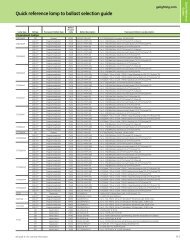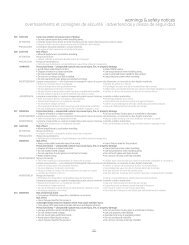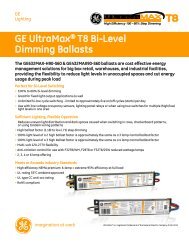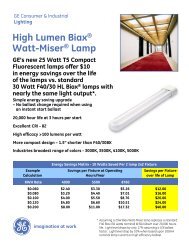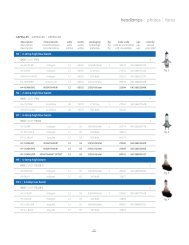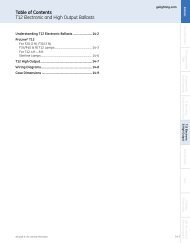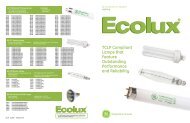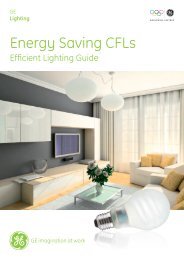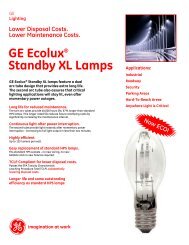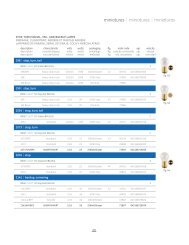Introduction & Index - GE Lighting Asia Pacific
Introduction & Index - GE Lighting Asia Pacific
Introduction & Index - GE Lighting Asia Pacific
Create successful ePaper yourself
Turn your PDF publications into a flip-book with our unique Google optimized e-Paper software.
Ambient Temperature<br />
It is important to consider the lamp housing from the standpoints of<br />
radiation, absorption, and ventilation. Normal variations in ambient<br />
temperature do not affect the performance of miniature lamps. Above<br />
175°C (350°F), the solder on conventional lamps may soften, deform, or<br />
melt, and the basing cement may loosen. All-glass wedge base lamps can<br />
be operated in lamp ambient temperatures of up to 230°C (450°F).<br />
Inrush Current<br />
The initial current through a filament is called the inrush current. Cold<br />
resistance of a filament is generally considered to be that of room temperature,<br />
while the hot resistance depends upon the temperature of the filament<br />
(which varies with lamp size). Inrush current can be approximately 12 times<br />
as great as the normal operating current. This maximum value is seldom<br />
reached because the impedance in the circuit reduces it. However, equipment<br />
designers should take both inrush current and resistance into consideration<br />
when selecting a lamp. Chart II displays the general range of inrush current<br />
versus time after voltage is applied to a cold lamp. Inrush current can be<br />
reduced by applying a low value of pre-heat voltage.<br />
Amperes (Times Normal)<br />
12<br />
11<br />
10<br />
9<br />
8<br />
7<br />
6<br />
5<br />
4<br />
Chart II<br />
Composite Inrush Current<br />
VS.<br />
Time With Design Volts Applied<br />
For Typical<br />
Miniature Lamps<br />
3<br />
2<br />
Normal<br />
Amperes<br />
0 10 20 30 40 50 60 70 80 90 100 110 120130 140 150<br />
Milliseconds<br />
Tungsten filaments are more fragile at temperatures below the 250°C<br />
brittle-ductile region. This fragility can be reduced by using a keep-alive<br />
voltage or current in the off condition. A general recommendation for<br />
keep-alive requirements is 25% of the design voltage or current. This will<br />
reduce the inrush current from approximately 12 times to 4 times,<br />
depending upon the lamp type.<br />
Incandescence and Nigrescence<br />
The rate of rise and decay time depends upon the mass of the filament to<br />
be heated. In general, the incandescence (rise time) to 90% brightness is<br />
about 100 to 300 milliseconds, and the nigrescence (decay time) is about<br />
40 to 100 milliseconds. These values vary with each lamp type. The times<br />
are directly related to the lamp current; therefore, low-current lamps<br />
have the fastest response times.<br />
Flashing and Pulsing<br />
Incandescent lamps have been used successfully in flashing and pulsing<br />
circuits. However, this may affect lamp life in some cases. For more<br />
information, contact your local <strong>GE</strong> Lamp Representative.<br />
Redundant System Philosophy<br />
Two-filament lamps with filaments connected in parallel for additional<br />
reliability are not new. Experience has shown, however, that in many<br />
cases, the second filament has failed by the time it is needed. Thus, these<br />
lamps have never become very popular.<br />
A more reliable system would be to use two or more lamps operating at<br />
the same time. Since they are physically separated from each other, it is<br />
easy to see when one has failed. This lamp can be replaced immediately,<br />
prior to the failure of the second lamp.<br />
Color Temperature<br />
The radiation from tungsten filaments used in General Electric lamps is<br />
similar to that from a “black body” at specific temperatures. This can be<br />
determined approximately from Chart III. Use the published lamp<br />
ratings (or estimated derated values) in this catalog. The catalog<br />
indicates whether a lamp is vacuum or gas-filled.<br />
Degrees Kelvin<br />
3200<br />
3000<br />
2800<br />
2600<br />
2400<br />
2200<br />
2000<br />
1800<br />
0<br />
Miniature Lamps<br />
Vacuum Lamps<br />
Chart III<br />
Gas Filled Lamps<br />
Approx. Color Temperature<br />
VS.<br />
Efficiency<br />
(Mean Spherical Candlepower Per Watt)<br />
.2 .4 .6 .8 1.0 1.2 1.4 1.6 1.8<br />
MSCP / Watt<br />
Lamp Life<br />
Rated average life is that obtained in closely controlled laboratory testing<br />
of lamps on 60 Hertz Alternating Current at their design voltage. Certain<br />
lamps are tested with Direct Current and are footnoted accordingly. Very<br />
long life lamps are generally rated on the basis of extrapolated laboratory<br />
test data. Service conditions such as shocks, vibration, voltage fluctuations,<br />
temperature, etc., may contribute to a shorter average service life.<br />
Ordinarily, for still-rack operation, normal tungsten filament evaporation<br />
is the basic force or mechanism controlling incandescent lamp life. Where<br />
normal filament evaporation is the dominant failure mechanism, lamps<br />
should reach their design-predicted lifetimes.<br />
Another filament mechanism has been identified which may reduce life to<br />
one-half or much less of its design-predicted value. It is commonly referred<br />
to as “filament notching.” Notching is the appearance of step-like or sawtooth<br />
irregularities, appearing on all or part of the tungsten filament surface, after<br />
extensive (e.g. 3000Hrs) burning.<br />
These notches reduce the filament wire diameter at various points. In<br />
some cases, especially in fine-wire diameter lamps, the notching is so<br />
severe as to almost penetrate the entire wire diameter. Thus accelerated<br />
spot evaporation due to this notching (as well as reduced filament<br />
strength) now becomes the dominant mechanism for influencing lamp<br />
life. Because of its abnormal evaporation and/or reduced strength<br />
effects, lamp lifetimes due to notching are substantially lessened.<br />
Notching has been due to at least three factors:<br />
1. Low-temperature filament operation, less than that for significant<br />
normal tungsten evaporation.<br />
2. Small filament-wire sizes, less than one mil (.001") diameter in<br />
many cases, typical of low- amperage lamps.<br />
3. Increased use of D.C. voltage operation<br />
Subminiature lamps,<br />
those with bulb sizes<br />
of T-2 and below, have<br />
been the most susceptible<br />
candidates for filament<br />
notching. Since notching<br />
is very difficult to predict,<br />
it is recommended that<br />
lamps susceptible to<br />
this phenomenon be<br />
easily replaceable in<br />
their applications.<br />
An example of filament notching.<br />
21




